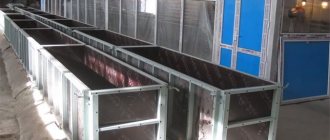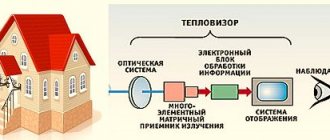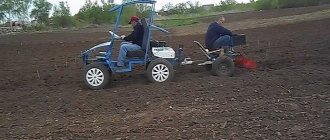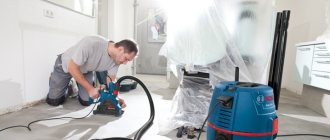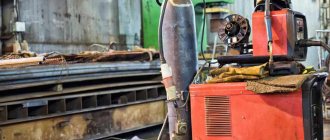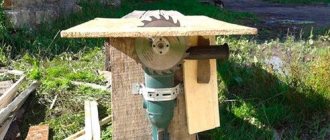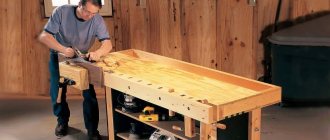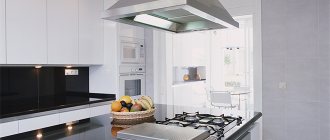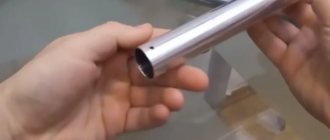Aerated concrete is a rather fragile material and can be drilled with any tools without any problems. Moreover, you can get by with a regular hammer and chisel. But in order to make the holes smoother and deeper, various nozzles are used.
It is recommended to drill aerated concrete with a hammerless drill or screwdriver.
So, different tasks require different holes in aerated concrete; this could be a regular hole for a dowel or anchor , or a place for an outlet , or a large cavity for a ventilation pipe.
In other words, holes are needed of different diameters and depths, which are made with conventional attachments: a drill, a wood pen and crowns .
If you need to make a deep hole with a crown, then you cannot do without an extension attachment . Having drilled a circle to the thickness of the crown, a piece of aerated concrete must be carefully broken off with a hammer and chisel, then, using the same pattern, drill circle by circle to the depth we need.
But there are also situations when you need to drill a hole of a very large diameter, and not necessarily a round one, but, for example, a square one. Now we will figure out how to do this.
How to fix a wooden beam to a wall?
If it is a small beam of light weight, then you can use bolts or self-tapping screws. Wedge-shaped bolts will be more appropriate, because they sit firmly in the material. A screw with threads along the entire length is also suitable. To fasten heavier structures, shelves or cabinets, metal or plastic dowels are needed.
Interesting materials:
How to connect a switch and a light bulb? How to connect to free Wi-Fi? How to connect to the Glonass system? How to connect to the Kcell tariff? How to connect to Wi-Fi on a train? How does a submarine rise and fall? How to climb with the help of Zhumar? How to choose a power supply for a laptop? How to choose a tie for a dark blue suit? How to choose a mini skirt?
How to make a large round hole in aerated concrete
- First you need to plan a place on the wall where there is no reinforcement.
- Draw a circle of the required diameter on the wall.
- Take a drill with a drill bit of the required length.
- Drill holes around the perimeter of the circle.
- Using the side surface of the drill, drill out the partitions between the holes.
- Gradually chip off the aerated concrete, or remove the entire piece if the hole is through.
- Next, simply level the hole using a hammer, sandpaper, and other tools.
Drill bit for aerated concrete: which one is better to use?
Walls built from any type of concrete have to be drilled to install hanging furniture, elements of plumbing and heating systems, and household appliances.
Concrete walls have to be drilled with a special tool. Most often, drilling as such is not used; drilling is done using a hammer drill. However, if it is necessary to work with relatively soft building materials, the use of conventional types of cutting tools is allowed. At the same time, there is a special drill for aerated concrete, designed for making large-diameter holes (from 50 mm and more). However, using a specialized tool is not the only way to drill holes in aerated concrete, especially when you consider that it is often necessary to drill a rectangular or complex-shaped socket. In most cases, improvised tools are used, often making do with an ordinary chisel and hammer. Let's take a closer look at this issue.
Chemical anchors
Such anchors are used for large and serious loads. Their installation is not difficult, but this will require a suitable tool and correct sizing.
- Initially, you need to drill a hole slightly larger than the diameter of the chemical anchor.
- The hole must be cleaned and blown out so that there is no dust inside.
- Next, take the adhesive composition, they need to fill the hole by about 70-75%.
- Then a metal pin is screwed in.
- When the glue is completely dry, you can continue working. Depending on the type of stud, different loads are applied.
Mauerlat fastening with chemical anchors
When erecting the roof of a house, it is necessary to arrange the rafters; for this you need to erect a wooden frame - a mauerlat.
It is most reliable to use steel studs that are installed on chemical anchors.
There are quite a few manufacturers, because the cost of chemical anchors is not small. One of the more famous suppliers is Tytan Professional EV-1.
Chemical anchors are also used for other fastenings, for example, poles, frames, etc.
Before you begin installing anchors, it is worth studying the information on the packaging in order to more accurately calculate the dimensions and center of gravity.
Foam block
Foam block is a material used in construction. It has a durable structure that has porous cells. A foam block is made from sand, cement and water using a foaming agent.
The building material has many advantages:
- lasting;
- durable;
- construction happens much faster.
Since the foam block has high-strength properties, the fastening must be selected accordingly. From the article you will learn what fasteners are used when working with foam blocks.
Types of fastenings for foam blocks
Fastenings when working with foam blocks are divided into two categories:
Using internal fastening, you can install various parts indoors. For example, lamps, sockets, paintings, etc.
Fixing to the outside of a building, larger jobs that require special attention and knowledge. Outside, work is being done to install drains, pipes, awnings, etc.
Foam block fastening can be used in several options:
- plastic mount;
- metal mount.
Such fasteners come in different compositions, and the price is different; better ones will be a little more expensive.
Before installing the mount into the foam block wall, you need to drill a hole. Then fasten the parts using one of the following methods:
All methods are good without exception, they are just used in different ways and for different levels of strength.
Selection of fasteners
In 99% of cases, craftsmen use a simple method of selecting fasteners for a part. What material is the part made of, and what type of fasteners should be selected. This does not mean that they should be identical, at least 70% close to each other. But, it is best to choose a fastener that is denser in material than the part itself.
What to consider when buying a toilet
Wall-hung toilets are primarily concerned with the same qualities as floor-standing ones: location of the drain hole, flushing efficiency, height of the siphon bend, quality of ceramics. Regarding flushing, it is recommended to give preference to the “whirlpool” type; the presence of holes in the front of the rim is very desirable.
Next, about innovations that significantly facilitate the comfort of use. Optionally, a wall-hung toilet can have:
- microlift, softening the closure of the lid when thrown;
- special coating of the bowl with minimal friction;
- system for removing unpleasant odors;
- function of “deep” flushing and protection against splashes of water.
Other subtleties concern the features of the installation system, which is selected separately. In particular, pay attention to the supporting frame. It must be made of galvanized steel profile, which has a height-adjustable top bar with longitudinal slots, otherwise difficulties may arise in bypassing communications during fastening. If you plan to install in a niche, choose a narrow installation option with a high tank. For some installations, the support legs can be rotated for more convenient installation inside a 50 or 75 mm profile. It is necessary to have a soundproofing gasket, studs and seals for the toilet. The fan pipe must be rotatable, adjustable in length and have an extension of 90–110 mm for easy connection to the toilet.
Regarding the tank and fittings for it: give preference to a separate (economical) flush device, also select the correct side for the water supply, or purchase a universal option. The rotary tap included in the kit must be of good quality and have a nut for screwing without tools. Each installation comes with an original button; you cannot choose another one. In most cases, the delivery set is complete, but it would not be superfluous to check the presence of all elements.
When the need arises
When building country houses, it is impossible to do without wooden structures. And they have to be somehow fastened with other materials. In some cases this action does not cause any difficulties, but in others it can become a problem.
For example, when wood comes into contact with concrete, it can begin to rot, so a waterproofing layer must be made between these materials. But in the case of foam concrete, there is also a risk of destruction of fragile blocks under the weight of a massive wooden structure.
Laying timber on a foam block and fixing it on it is necessary if:
- The project provides for a second floor made of timber or a wooden frame. Such combined buildings are very popular, as they save money and time spent on construction;
To erect a wooden second floor, the first beam must be rigidly fixed to the wall made of foam blocks
- It is necessary to secure the roof rafter system to the box;
Installation of rafters
- It was decided to make the floors wooden, on beams made of timber or logs. This option is most often chosen for foam concrete houses, so as not to create an increased load on the walls from reinforced concrete floor slabs.
Floor beams
In all these cases, the fastening must be reliable so that neither hurricane winds, nor seasonal soil movements, nor any other factors can damage the integrity of the building.
Advice. The timber must be dry. During the drying process, raw wood can be greatly deformed and, if fastened tightly, destroy the walls. If there is any doubt about the dryness of the log house, the fasteners should be made sufficiently loose in the horizontal plane.
Advice from experienced builders
Experienced builders advise avoiding the ability to attach heavy structures to the foam block. If this is not possible, then it is necessary to use high-quality chemical anchors for installation. Also, builders do not recommend using power tools to screw in hardware. A powerful screwdriver is capable of pulling out even an installed chemical anchor from a foam block, not to mention ordinary dowels.
The video below compares the reliability of fastening chemical anchors, screws for foam concrete and iron dowels for foam concrete:
Verdict
Various types of fasteners allow you to carry out all the finishing work on the facade of the house, as well as safely install various equipment - air conditioners, heating devices, shelves, etc.
But for each type of mounted equipment, it is necessary to select its own mount, designed for its load. This will be the main feature of working with foam block walls.
Foam block and gas block are not very expensive materials. Mounts for it are also not expensive. And if you also choose plastic fasteners, you will get serious savings and the cost will be generally minimal.
How to make a square hole in aerated concrete
A square through hole is made with an aerated concrete saw , or a regular wood saw. First, mark the square, drill holes with crowns or drills in the corners of the square so that the saw can fit in, and start sawing. Try to keep the saw perpendicular to the wall, this will make the hole smoother. Clean out small irregularities with sandpaper.
Working with aerated concrete is quite simple, but this advantage becomes a significant disadvantage. The problem is home security. Intruders can make a hole in the wall of a house through which they can penetrate and the consequences will be dire. To avoid such situations, aerated concrete is faced with brick or a thick layer of plaster. Build wisely, and so that everything goes well for you.
Famous brands
Installations are presented on the market by manufacturers from many countries.
The most common are Vitra from Turkey, ROCA from Spain, CERSANIT from Poland, IDDIS from Russia. In first place is the manufacturer GEBERIT from Germany, producing tanks without a single seam. In second place in the ranking are the companies GROhe Viega, followed by TECE. When installing the system, you must remember that the shelf life and strength of the structure can be reduced if installed incorrectly, due to bad water, or by violating the rules of use.
Types of dowels
On the construction market you can find dowels of different lengths and thicknesses, made of alloy or plastic. They are intended for internal or external work.
- Hammers. Designed for installation of building structures.
- Twisting. Sleeves pushing the walls apart in the hole. Designed for heavy loads.
Also for cellular concrete there are chemical fasteners that provide the highest fixation. Such a dowel, expanding, creates a support inside the block, which prevents the upcoming destruction of the fragile material.
According to production material:
- Alloy (brass, aluminum, stainless steel, galvanized). Suitable for places with the highest fire safety requirements. Used for fastening heavy objects, building structures, etc. Equipped with spacer elements and external teeth that increase fastening ability.
- Nylon. Suitable for construction and installation work. Not subject to wear, considered durable and strong. Suitable for fastening light objects.
- Cellophane, polypropylene. Used in highly specialized areas.
Screws for foam blocks are used very rarely, because they simply destroy fragile walls. Screws with an expanding element are used for dense aerated concrete and foam concrete. They are simply installed, securely fixing the desired item.
, chemical anchors are most often used . Their system is not particularly complex. This product consists of a threaded iron screw, a sleeve/bushing and an adhesive. The adhesive composition can be based on epoxy, epoxyacrylate, polyester, vinylester resin.
The fasteners are built into the block, spreading the glue from the inside, which prevents the destruction of the material.
Chemical fixatives are successfully used for interior and exterior work. They are easy to install, universally suitable, non-hazardous, resistant to frost and heat.
Disadvantages: serious adherence to technology during installation, the need to purchase special tools (drills, brush, pump, gun), waste of time for the adhesive composition to harden.
Aspects of choice
When choosing dowels for aerated concrete and foam concrete, you need to take into account the type of work planned . The more complex the system and the longer the product, the more loads it can withstand:
- installation of light objects - plastic fasteners with a diameter of 4-12 mm;
- installation of hanging equipment , massive furniture, equipment - iron anchors;
- installation of doors and windows - metric screws made of plastic or alloy.
More common options:
- Spiral plastic dowels. The fasteners are securely fixed thanks to the outer blades that expand in the hole. Installed with a few blows of a hammer.
- Turbo dowels made of plastic for aerated concrete . They do not exert expansion pressure at the point of fixation. Therefore, they can be strengthened with a small distance from each other. Installed by screwing into a pre-drilled hole. They are controlled with fasteners with medium overloads, for example, lighting devices.
- Turbo dowels made of zinc coated steel . Effortlessly screw into the hole using a hexagon. They ensure a strong fit inside the block, do not apply spacer pressure, so they can be installed side by side together. Withstands huge overloads.
Interesting read: How to drill a hole in a concrete wall with a drill
Chemical anchors are suitable for fastening, providing the highest fixation in various options (including heavy structures).
Which drills are suitable for working with aerated concrete?
In order to make a hole in a gas block, drills of different designs can be used. In terms of hardness and combination of other qualities, the material is closest to wood, therefore, the choice of cutting tools is quite wide. As a rule, to perform one-time, small operations, use drills that are at hand. However, if you plan to perform a large amount of work, you need to prepare in advance and acquire the necessary number of suitable tools. Let's take a closer look at the types of drills suitable for working with aerated concrete:
Metal drill
This type of drill is the most popular and is well known to all home craftsmen. The tool resembles an Archimedes screw with an elongated thread in two threads. The cutting edges are sharpened at an angle of 60° to the frontal plane. At the same time, the angle of attack can be changed, achieving the most effective use of cutting edges in a given material. To do this, you need to use a sharpening machine with adjustable parameters, which not everyone has, so most craftsmen sharpen drills “by eye.” For most working operations, this is quite enough, the main thing is that the cutting edges are correctly backed - they protrude slightly forward in relation to the back side.
In order to make a hole in a gas block, a metal drill is quite suitable. The only limitation is the diameter - the maximum shank size available for installation in a standard chuck of the most powerful electric drill is 16 mm.
Screw drill for wood
Wood and aerated concrete are similar in their mechanical qualities. Therefore, using a wood drill is a completely acceptable solution to the problem. Externally, such equipment differs little from the most common type of drill (for metal). However, if you look at the working part, you can immediately notice a significant difference in sharpening - a well-developed central spike and protruding edges of the cutting edges. During operation, the center allows you to more accurately maintain the direction without leaving the axis of the hole, and the protruding edges of the edges make the inlet hole and internal walls more even.
Correct use of fasteners
To begin with, it is worth considering the above-mentioned disadvantages of the foam block:
- Hygroscopicity . This interesting property of the foam block can be considered both an advantage and a disadvantage when the material becomes saturated with moisture;
- Low density . There are also two opinions here: the advantage is that the weight on the foundation is reduced, and the disadvantage is that choosing a fastening for foam concrete becomes an exciting task.
Now let’s talk in more detail about the last point.
